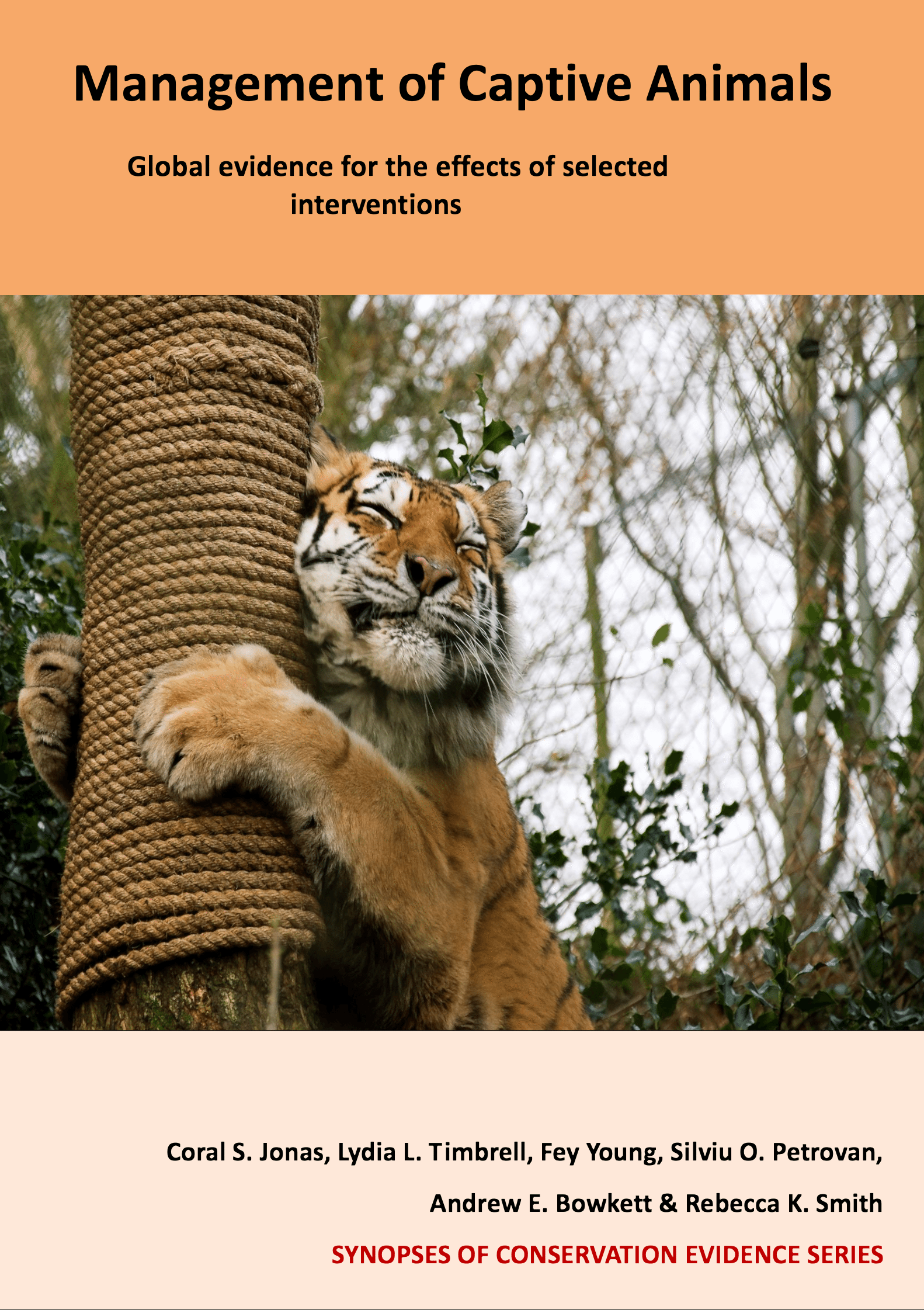Carnivores: Provide bones, hides or partial carcasses
Overall effectiveness category Likely to be beneficial
Number of studies: 4
View assessment score
Hide assessment score
How is the evidence assessed?
Effectiveness
80%Certainty
60%Harms
0%
Study locations
Supporting evidence from individual studies
A replicated, before-and-after study in 2003 of lions Panthera leo and tigers Panthera tigris in a zoo in the USA found that when presented with bones twice a week as enrichment in addition to a commercial diet, stereotypic behaviours decreased compared to a commercial diet without bones. The presentation of bones twice a week on fed days, reduced the frequency of stereotypic behaviours (0.17 proportion of scans) compared to their routine commercial diet with one bone presented on fast days (0.28 proportion of scans). When presented in the morning, the frequency of resting (65%), standing (14%) and consumptive (3%) behaviours increased compared to when fed the commercial diet (resting: 35%; standing: 5%; consumptive: 0%). Before the experiment, the five cats were fed ground beef-based commercial diet six days a week and were not fed on the seventh day, instead they received a horse leg bone. There were four conditions in the experiment, each condition lasted four weeks 1) baseline data 2) bones were supplied twice per week 3) Live fish were supplied twice per week which were placed inside water pools. 4) A post-manipulation baseline was measured (for tigers only). Each cat was observed for one-hour sessions using instantaneous scan sampling at one-minute intervals for a minimum of six hours per cat.
Study and other actions testedA replicated, before-and-after study in 2007 of tigers Panthera tigris, ocelots Leopardus pardalis, cougars Puma concolor, cheetahs Acinonyx jubatus and lions Panthera leo in a zoo in the USA found that when provisioned with bones active behaviours increased compared to no added enrichment. Active behaviours, excluding pacing, increased when provisioned with bones (31%) compared to no added enrichment (16%). This study was conducted on fourteen felids. Baseline data was collected before the investigation and two weeks of no enrichment occurred between each treatment. Horse knuckle or shank bone were provided daily for seven consecutive days (four days for tigers). Each cat was observed for one 30-minute session/day for ten days over a period of four weeks prior to enrichment and for two 30-minute session/day over three days during treatments using instantaneous scan sampling.
Study and other actions testedA replicated, controlled study in 2009 of Arctic foxes Vulpes lagopus in a research facility in Finland found that when a cattle femur bone was provided as enrichment, foxes performed less oral stereotypies and engaged in more solitary play (mean values not reported). Foxes in the enrichment group interacted with bones for 50 minutes a day (3–4% of the observations). Sixteen fox families were used in this experiment. A frozen and defrosted cattle femur was placed into every second cage of a row. Foxes that were not provided with a bone could still see and smell the bones. All foxes were fed twice daily. Instantaneous focal sampling from video recordings were undertaken at five minute intervals for three 24-hour periods over four months.
Study and other actions testedA replicated, before-and-after study in 2013 of red foxes Vulpes vulpes in a research facility in Norway, found that presenting a cattle bone increased time interaction/manipulation time and reduced latency to contact than presenting foxes with a pulling device, straw, rawhide bone or a plastic cube. Within the first hour of presentation, foxes spent more time (1751 seconds/hour) manipulating the cattle bone and the latency to contact was shorter (mean values not reported) compared to a pulling device (62.4 s/hour), straw (31 s/hour), rawhide bone (313 s/hour) and cubes (24 s/hour). On the second day, time spent in manipulation was higher for the cattle bone (70.7 s/hour) than the other objects (0-21.7 s/hour), except for the rawhide (111.9 s/hour), and was again highest for the cattle bone on the fourth day (152.3 s/hour). Thirty juvenile foxes were individually housed and fed a food paste daily as desired. Enrichment objects included a pulling device (metal wire and plastic tubes), straws, pressed rawhide dog bone, cattle femur bone, and plastic cube. The experiment included an adjustment, habituation, deprivation, and reintroduction period. All objects were made available to the foxes at the same time. Continuous sampling was used for the first hour in the reintroduction period and then for one hour after access on the second and fourth day.
Study and other actions tested
Where has this evidence come from?
List of journals searched by synopsis
All the journals searched for all synopses
This Action forms part of the Action Synopsis:
Management of Captive Animals
Management of Captive Animals - Published 2018
Captive Animal Synopsis




















